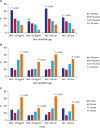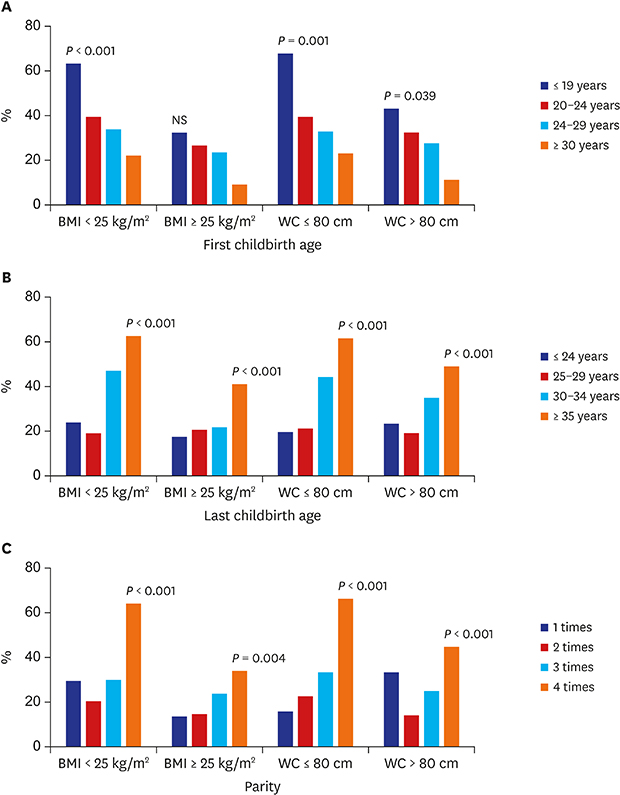1. Lane NE. Epidemiology, etiology, and diagnosis of osteoporosis. Am J Obstet Gynecol. 2006; 194(2):Suppl. S3–S11.

2. Tella SH, Gallagher JC. Prevention and treatment of postmenopausal osteoporosis. J Steroid Biochem Mol Biol. 2014; 142:155–170.

3. Diab DL, Watts NB. Postmenopausal osteoporosis. Curr Opin Endocrinol Diabetes Obes. 2013; 20(6):501–509.

4. Mpalaris V, Anagnostis P, Goulis DG, Iakovou I. Complex association between body weight and fracture risk in postmenopausal women. Obes Rev. 2015; 16(3):225–233.

5. Cavkaytar S, Seval MM, Atak Z, Findik RB, Ture S, Kokanali D. Effect of reproductive history, lactation, first pregnancy age and dietary habits on bone mineral density in natural postmenopausal women. Aging Clin Exp Res. 2015; 27(5):689–694.

6. Cho GJ, Shin JH, Yi KW, Park HT, Kim T, Hur JY, et al. Adolescent pregnancy is associated with osteoporosis in postmenopausal women. Menopause. 2012; 19(4):456–460.

7. Miglioli L, Costa-Paiva L, de Lourenço LS, Morais SS, Lopes de Lima MC, Pinto-Neto AM. The association of pregnancy history with areal and volumetric bone mineral density in adolescence. Osteoporos Int. 2007; 18(1):101–108.

8. Ahn E, Lee J, Park YS, Noh HM, Kim BH. Association between delivery at an advanced maternal age and osteoporosis in elderly Korean women. J Bone Miner Metab. 2015; 33(6):666–673.

9. Kweon S, Kim Y, Jang MJ, Kim Y, Kim K, Choi S, et al. Data resource profile: the Korea National Health and Nutrition Examination Survey (KNHANES). Int J Epidemiol. 2014; 43(1):69–77.

10. Diab DL, Watts NB. Diagnosis and treatment of osteoporosis in older adults. Endocrinol Metab Clin North Am. 2013; 42(2):305–317.

11. Binkley N, Bilezikian JP, Kendler DL, Leib ES, Lewiecki EM, Petak SM, et al. Official positions of the International Society for Clinical Densitometry and Executive Summary of the 2005 Position Development Conference. J Clin Densitom. 2006; 9(1):4–14.

12. Nam GE, Cho KH, Park YG, Han KD, Choi YS, Kim SM, et al. Socioeconomic status and dyslipidemia in Korean adults: the 2008–2010 Korea National Health and Nutrition Examination Survey. Prev Med. 2013; 57(4):304–309.

13. Wen W, Gao YT, Shu XO, Yang G, Li HL, Jin F, et al. Sociodemographic, behavioral, and reproductive factors associated with weight gain in Chinese women. Int J Obes Relat Metab Disord. 2003; 27(8):933–940.

14. Gur A, Nas K, Cevik R, Sarac AJ, Ataoglu S, Karakoc M. Influence of number of pregnancies on bone mineral density in postmenopausal women of different age groups. J Bone Miner Metab. 2003; 21(4):234–241.
15. Ozdemir F, Demirbag D, Rodoplu M. Reproductive factors affecting the bone mineral density in postmenopausal women. Tohoku J Exp Med. 2005; 205(3):277–285.

16. Shin CS, Choi HJ, Kim MJ, Kim JT, Yu SH, Koo BK, et al. Prevalence and risk factors of osteoporosis in Korea: a community-based cohort study with lumbar spine and hip bone mineral density. Bone. 2010; 47(2):378–387.

17. Lenora J, Lekamwasam S, Karlsson MK. Effects of multiparity and prolonged breast-feeding on maternal bone mineral density: a community-based cross-sectional study. BMC Womens Health. 2009; 9:19.

18. Sioka C, Fotopoulos A, Georgiou A, Xourgia X, Papadopoulos A, Kalef-Ezra JA. Age at menarche, age at menopause and duration of fertility as risk factors for osteoporosis. Climacteric. 2010; 13(1):63–71.

19. Kauppi M, Heliövaara M, Impivaara O, Knekt P, Jula A. Parity and risk of hip fracture in postmenopausal women. Osteoporos Int. 2011; 22(6):1765–1771.

20. Wang Q, Huang Q, Zeng Y, Liang JJ, Liu SY, Gu X, et al. Parity and osteoporotic fracture risk in postmenopausal women: a dose-response meta-analysis of prospective studies. Osteoporos Int. 2016; 27(1):319–330.

21. Okyay DO, Okyay E, Dogan E, Kurtulmus S, Acet F, Taner CE. Prolonged breast-feeding is an independent risk factor for postmenopausal osteoporosis. Maturitas. 2013; 74(3):270–275.

22. Sabatier JP, Guaydier-Souquières G, Laroche D, Benmalek A, Fournier L, Guillon-Metz F, et al. Bone mineral acquisition during adolescence and early adulthood: a study in 574 healthy females 10–24 years of age. Osteoporos Int. 1996; 6(2):141–148.

23. Yun BH, Choi YR, Choi YS, Cho S, Lee BS, Seo SK. Age at first delivery and osteoporosis risk in Korean postmenopausal women: The 2008–2011 Korea National Health and Nutrition Examination Survey (KNHANES). PLoS One. 2015; 10(5):e0123665.

24. Sahin Ersoy G, Giray B, Subas S, Simsek E, Sakin O, Turhan OT, et al. Interpregnancy interval as a risk factor for postmenopausal osteoporosis. Maturitas. 2015; 82(2):236–240.

25. Salari P, Abdollahi M. The influence of pregnancy and lactation on maternal bone health: a systematic review. J Family Reprod Health. 2014; 8(4):135–148.
26. Tsvetov G, Levy S, Benbassat C, Shraga-Slutzky I, Hirsch D. Influence of number of deliveries and total breast-feeding time on bone mineral density in premenopausal and young postmenopausal women. Maturitas. 2014; 77(3):249–254.

27. Schnatz PF, Barker KG, Marakovits KA, O'Sullivan DM. Effects of age at first pregnancy and breast-feeding on the development of postmenopausal osteoporosis. Menopause. 2010; 17(6):1161–1166.

28. Abrams SA. Normal acquisition and loss of bone mass. Horm Res. 2003; 60:Suppl 3. 71–76.

29. Karlsson C, Obrant KJ, Karlsson M. Pregnancy and lactation confer reversible bone loss in humans. Osteoporos Int. 2001; 12(10):828–834.

30. Pirkle CM, de Albuquerque Sousa AC, Alvarado B, Zunzunegui MV. IMIAS Research Group. Early maternal age at first birth is associated with chronic diseases and poor physical performance in older age: cross-sectional analysis from the International Mobility in Aging Study. BMC Public Health. 2014; 14:293.

31. Heidari B, Hosseini R, Javadian Y, Bijani A, Sateri MH, Nouroddini HG. Factors affecting bone mineral density in postmenopausal women. Arch Osteoporos. 2015; 10:15.

32. Kim KC, Shin DH, Lee SY, Im JA, Lee DC. Relation between obesity and bone mineral density and vertebral fractures in Korean postmenopausal women. Yonsei Med J. 2010; 51(6):857–863.








 PDF
PDF Citation
Citation Print
Print




 XML Download
XML Download